Key takeaways
- Pro Tools is a powerful digital audio workstation that enhances creativity through advanced recording, editing, and mixing features.
- A strong musician portfolio combines music and personal storytelling, effectively connecting with fans and collaborators.
- Organization and simplicity in mixing are crucial for an efficient workflow and high-quality sound production.
- Collaboration is seamless with Pro Tools, allowing musicians to work together from different locations, fostering creative growth.
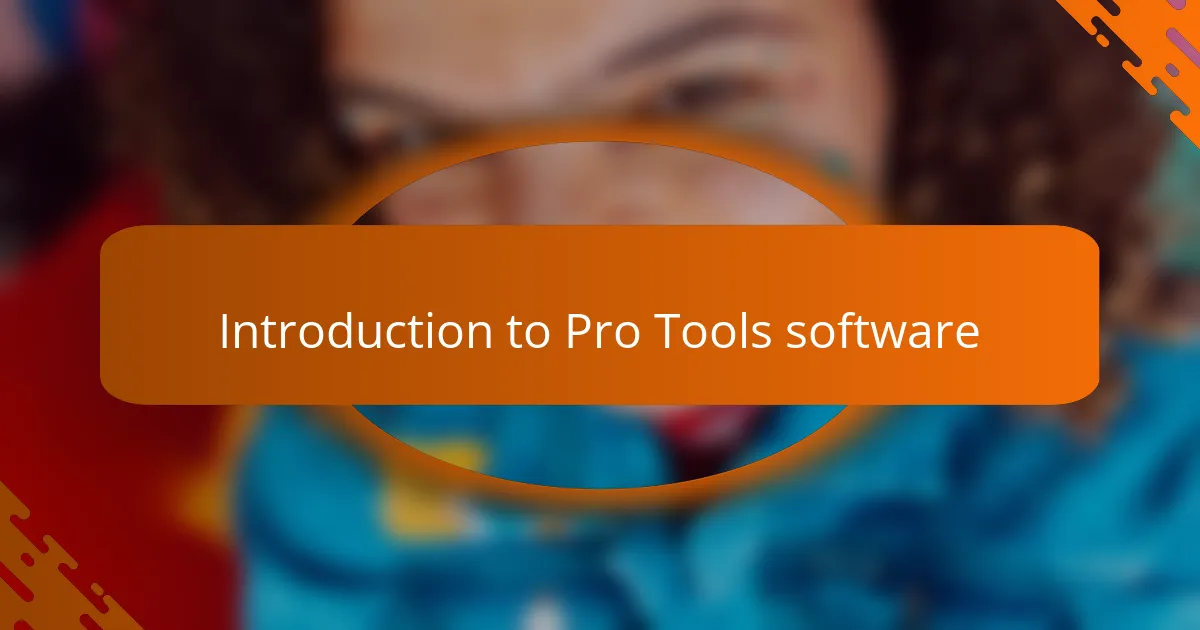
Introduction to Pro Tools software
Pro Tools is a digital audio workstation that has become a favorite among musicians and producers alike. My initial experience with it was both exciting and overwhelming. The array of features available—from multitrack recording to advanced editing tools—made me feel like I was stepping into a professional studio.
As I navigated the software, I vividly recall the satisfaction of finding the perfect plugin to enhance my mixes. Each session felt like an opportunity to learn something new, and that learning curve filled me with both challenge and joy. Pro Tools truly allowed me to unleash my creativity and refine my sound as a musician.
Here’s a comparison table to highlight some key aspects of Pro Tools software:
| Aspect | Detail |
|---|---|
| Audio Recording | Multitrack recording with high track count |
| Editing Features | Advanced editing tools for precise control |
| Plugin Support | Wide range of third-party plugins available |
| User Interface | Intuitive yet complex for new users |
| Learning Curve | Steep but rewarding |
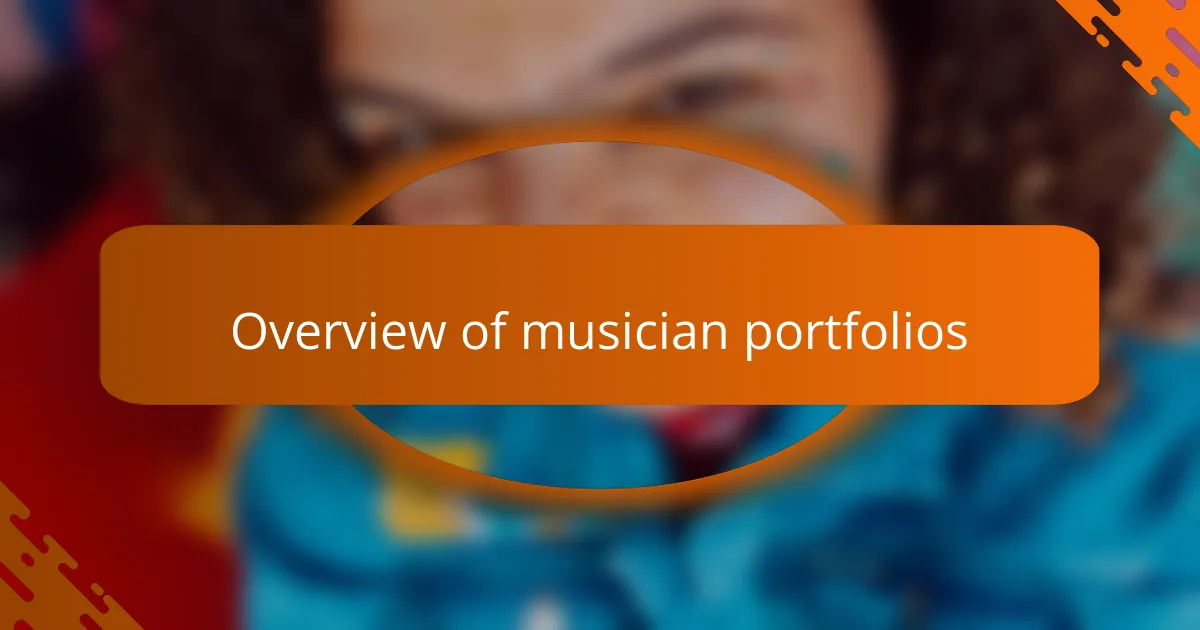
Overview of musician portfolios
A musician portfolio is a digital showcase of an artist’s work, experience, and skills. I’ve found that a strong portfolio can profoundly impact how potential collaborators and fans perceive an artist. It’s not just about listing tracks; it’s about creating a narrative that captures your unique sound and journey as a musician.
When I created my portfolio, I wanted to reflect not only my music but also my personality. By including various aspects such as recordings, live performances, and even written pieces about my influences, I aimed to tell my story in a way that resonates emotionally with others. This holistic approach helped me connect with listeners and fellow musicians on a deeper level.
Here’s a comparison of different platforms often used for musician portfolios:
| Platform | Features |
|---|---|
| Bandcamp | Direct sales, customizable pages, fan engagement |
| SoundCloud | Audio hosting, community feedback, track collaboration |
| Wix/Squarespace | Custom designs, various multimedia support, integrated ecommerce |
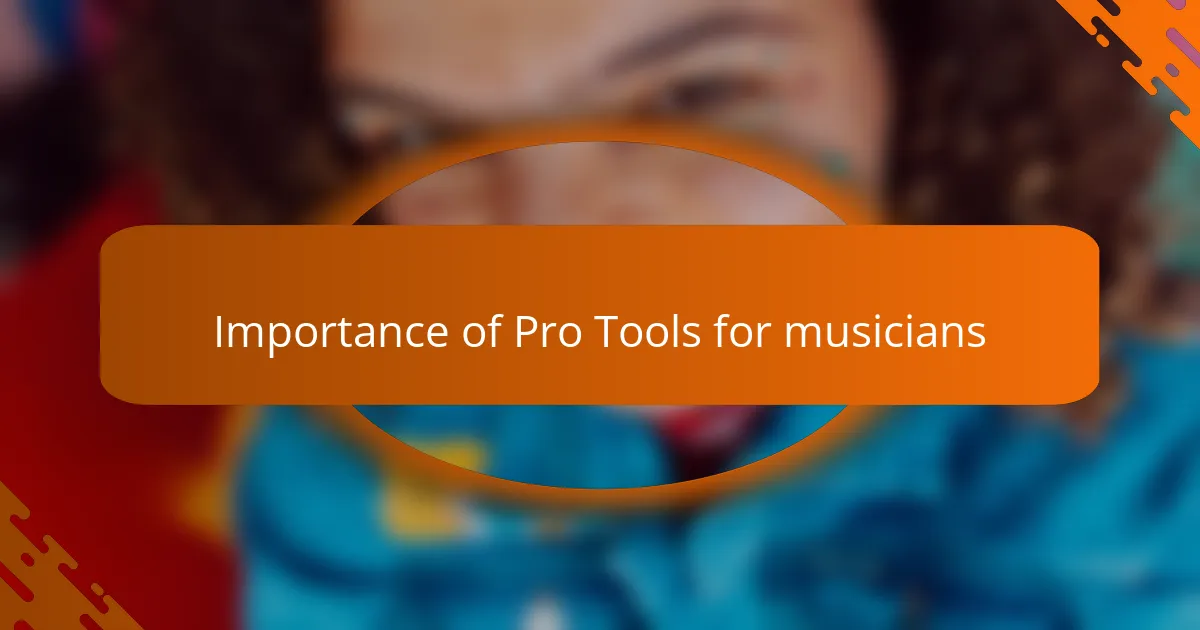
Importance of Pro Tools for musicians
Pro Tools has become an essential tool for musicians like myself, playing a pivotal role in how we create and produce music. The software offers powerful recording, editing, and mixing capabilities, which can elevate a home studio setup to professional standards. When I first started using Pro Tools, I was amazed by how intuitive it felt, allowing me to focus more on my creativity rather than getting bogged down in technical details.
The importance of Pro Tools extends beyond just functionality. It fosters collaboration, enabling musicians to work seamlessly with others, regardless of their location. I remember collaborating on a track with a friend hundreds of miles away; using Pro Tools made it feel like we were in the same room. This flexibility added so much value to our collaborative process, and I truly believe it can unlock new creative avenues for many artists.
- Industry standard for music production
- Versatile tools for recording and editing
- Seamless collaboration with other musicians
- High-quality sound processing and effects
- Regular updates and support from Avid, the parent company
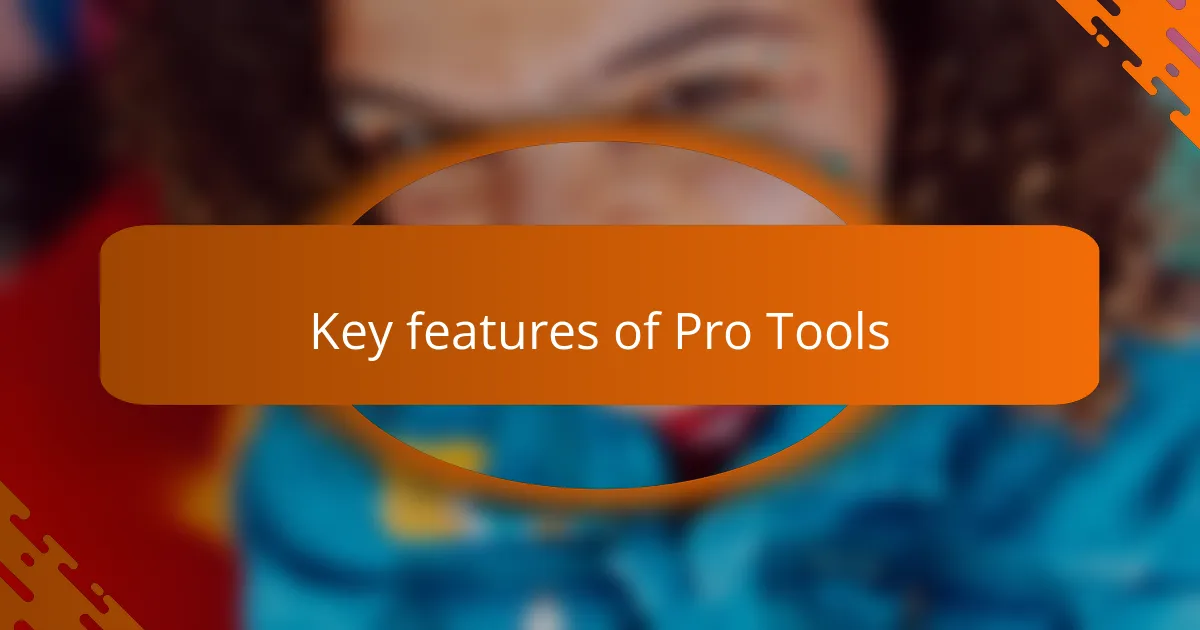
Key features of Pro Tools
Pro Tools stands out for its extensive multitrack recording capabilities. I vividly remember the first time I filled my session with dozens of tracks, layering instruments and vocals seamlessly. The thrill of hearing my ideas come to life, all while witnessing high track counts without a hitch, was exhilarating. It truly felt like having an entire studio at my fingertips.
One of the features that impacted my workflow significantly has been the advanced editing tools. I often find myself spending hours fine-tuning my recordings, thanks to the precision these tools offer. The ability to manipulate audio with such control has allowed me to experiment and refine my sound, often leading to unexpected but delightful results. Have you ever tweaked a vocal line and stumbled upon a rhythm that perfectly captures the song’s emotion? That’s the magic Pro Tools can help create.
The intuitive interface, while seemingly complex at first, quickly became a second language for me. I recall feeling a wave of accomplishment the day I navigated through various functions without needing to consult a tutorial. It goes to show that with a little patience and determination, even the steep learning curve can turn into a rewarding journey. How many other software platforms can offer this blend of challenges and growth? For me, the answer is none quite like Pro Tools.
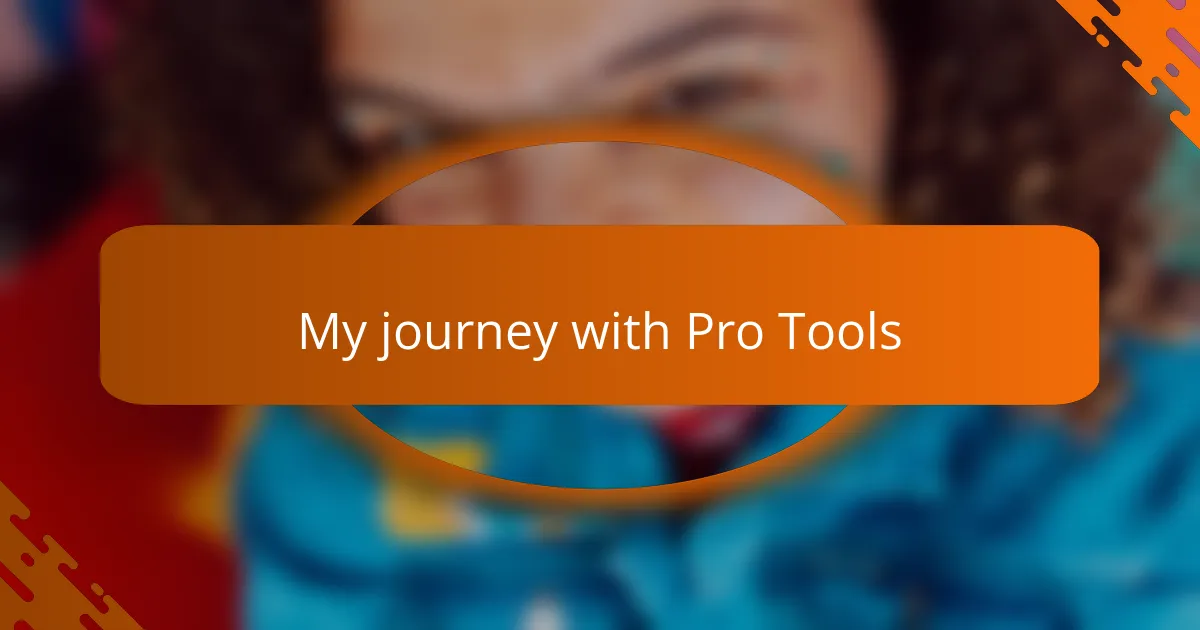
My journey with Pro Tools
Navigating through my journey with Pro Tools has been nothing short of transformative. I remember sitting in my makeshift home studio, surrounded by gear, feeling both excitement and trepidation as I first opened the software. The interface seemed overwhelming at first, but with each session, I uncovered features that inspired me to push my creative boundaries. I’d ask myself, “What could I create today?” That sense of exploration kept the spark of creativity alive.
As I became more comfortable, I found that the advanced editing tools became my best friends. I’ll never forget the moment I meticulously adjusted a guitar riff, trimming it to perfection, and realized I had struck gold with my sound. It was one of those rare moments in music production where everything clicked—pure magic. Have you ever experienced that feeling when a piece you’ve worked on suddenly feels so right? That’s what Pro Tools has done for my music.
Looking back, I can see how Pro Tools has shaped my artistic journey. Each project has been a lesson, and I’ve grown not just as a musician, but also as a storyteller. I often find myself thinking about how this software has provided me with the tools to share my experiences and emotions through music. It makes me wonder—how many artists out there are waiting to find their voice, just like I did? Pro Tools doesn’t just facilitate music creation; it fosters a deeper connection to our artistry.
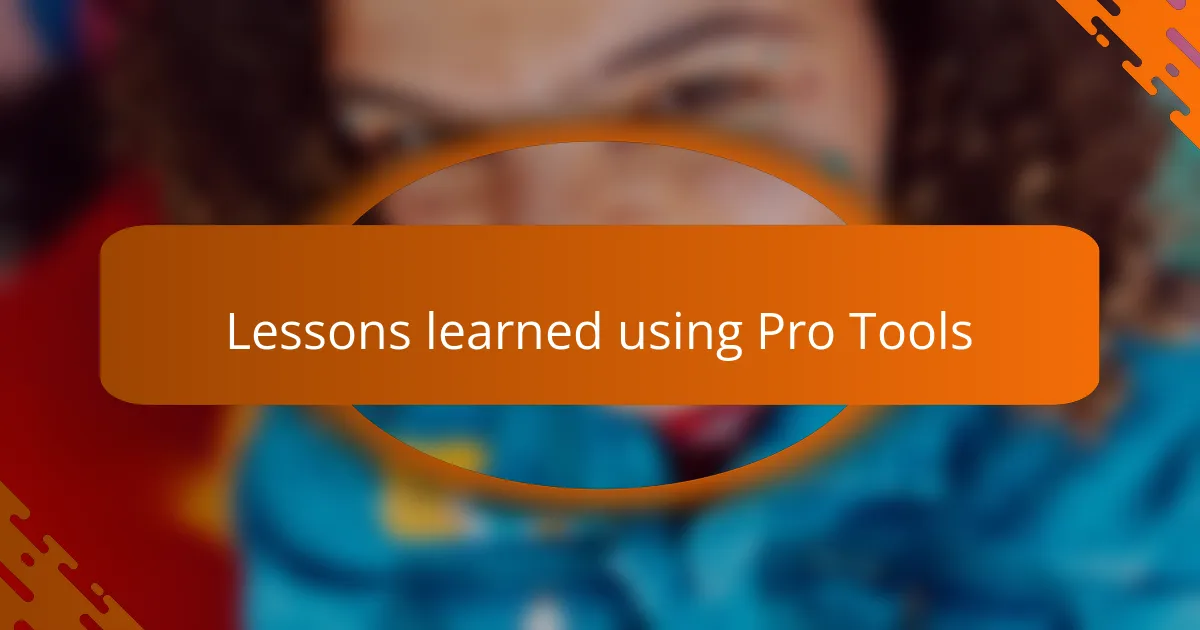
Lessons learned using Pro Tools
Diving into Pro Tools has been an enlightening journey for me. One of the key lessons I’ve learned is the importance of organization within sessions. Initially, I would record multiple takes without proper labeling, which led to a chaotic workspace. After struggling to find the right takes, I realized that labeling everything clearly, from tracks to plugins, saved me hours in post-production.
Another significant lesson came when I experimented with the software’s mixing capabilities. During a project, I got carried away with adding effects, only to find the mix sounding cluttered. This taught me the art of restraint and the power of simplicity in mixing. Trust me, less is often more.
- Always label tracks and takes clearly for easy navigation.
- Use color coding to differentiate between instruments and vocals.
- Focus on simplicity in mixing to avoid clutter.
- Regularly save your sessions to prevent data loss.
- Don’t hesitate to explore different plugins but be mindful of over-processing.